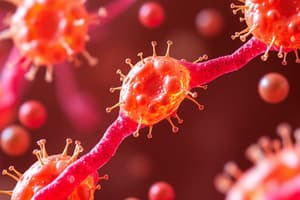Podcast
Questions and Answers
What is the primary function of the Golgi apparatus?
What is the primary function of the Golgi apparatus?
- To synthesize lipids and proteins
- To convert energy into ATP
- To direct where proteins and lipids are supposed to go (correct)
- To carry nutrients to the cytoplasm
How do lysosomes contribute to cellular function?
How do lysosomes contribute to cellular function?
- They store nutrients for the cell
- They contain digestive enzymes to break down substances (correct)
- They capture energy from light
- They synthesize proteins for cellular repair
What is the role of mitochondria in the cell?
What is the role of mitochondria in the cell?
- To provide structural support
- To transport proteins to the membrane
- To conduct photosynthesis
- To supply energy needed for cellular operations (correct)
Which process occurs in mitochondria to produce ATP?
Which process occurs in mitochondria to produce ATP?
Why can thylakoids capture energy from light?
Why can thylakoids capture energy from light?
What is a notable feature of both mitochondria and chloroplasts?
What is a notable feature of both mitochondria and chloroplasts?
What is the composition of the cytoskeleton?
What is the composition of the cytoskeleton?
What characteristic allows cytoskeleton components to change shape?
What characteristic allows cytoskeleton components to change shape?
What is the main structure of a phospholipid in plasma membranes?
What is the main structure of a phospholipid in plasma membranes?
What is the function of the selectively permeable membrane?
What is the function of the selectively permeable membrane?
Which characteristic differentiates prokaryotic cells from eukaryotic cells?
Which characteristic differentiates prokaryotic cells from eukaryotic cells?
What is the primary role of ribosomes in the endoplasmic reticulum?
What is the primary role of ribosomes in the endoplasmic reticulum?
What does the nuclear envelope do?
What does the nuclear envelope do?
Which component is NOT typically found in prokaryotic cells?
Which component is NOT typically found in prokaryotic cells?
What structure is primarily involved in building proteins and lipids?
What structure is primarily involved in building proteins and lipids?
What allows for the hydrophobic and hydrophilic characteristics of phospholipids?
What allows for the hydrophobic and hydrophilic characteristics of phospholipids?
Flashcards are hidden until you start studying
Study Notes
Plasma Membranes
- Encloses the cell.
- Composed of a phospholipid bilayer: two layers of phospholipids.
- Phospholipids have hydrophilic (water-attracting) heads and hydrophobic (water-repelling) tails.
- Hydrophilic heads face outward towards water; hydrophobic tails face inward, away from water.
- Selectively permeable membrane; regulates what enters and exits the cell via protein channels.
Prokaryotic Basic Cell Structure (Bacteria & Archaea)
- Lack a nucleus and membrane-bound organelles.
- Possess a cell membrane and a cell wall (composition varies between bacteria and archaea).
- Significantly smaller than eukaryotic cells.
- Contain DNA, RNA, proteins, and ions within the cytosol (everything inside the cell membrane).
Eukaryotic Structures (Animals & Plants)
- Share many common features.
- Cytoplasm: The internal environment of the cell membrane.
- Nucleus: Contains DNA; sends instructions for cell function. Surrounded by a nuclear envelope (double membrane).
- Endoplasmic Reticulum (ER): Attached to the nucleus; a primary site for protein and lipid synthesis. Rough ER has ribosomes; smooth ER produces lipids and membrane-bound vesicles for transporting proteins.
- Golgi Apparatus: Processes and packages proteins and lipids; directs their transport within or out of the cell via vesicles.
- Lysosomes: Contain digestive enzymes; can merge with vesicles to break down materials.
- Vacuoles: Larger in plant cells; store water, nutrients, and waste.
- Mitochondria: The "powerhouse" of the cell; generate ATP (energy) through aerobic respiration (using oxygen and sugars). Double-membraned; cristae (inner membrane folds) increase surface area for ATP production.
- Chloroplasts (Plants & some protists): Double-membraned; contain thylakoids (internal membrane stacks) where photosynthesis occurs. Chlorophyll is the pigment capturing light energy to convert carbon dioxide and water into sugars.
- Cytoskeleton: Internal network of fibers and tubules providing structural support and enabling changes in cell shape. Composed of protein filaments and constantly reforming due to non-covalent bonds.
Endosymbiotic Relationship
- Mitochondria and chloroplasts may have originated through an endosymbiotic relationship, where a smaller cell lived inside a larger cell.
- Both contain their own DNA and divide independently within the larger cell.
Studying That Suits You
Use AI to generate personalized quizzes and flashcards to suit your learning preferences.




